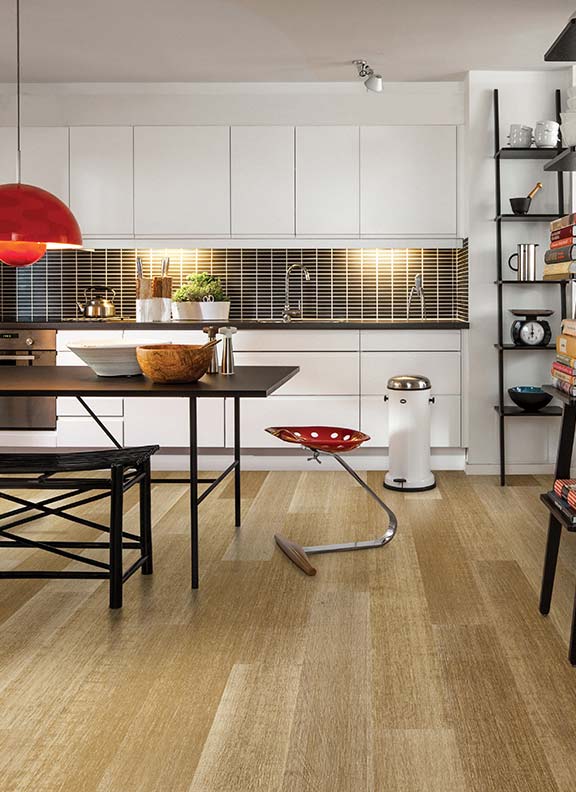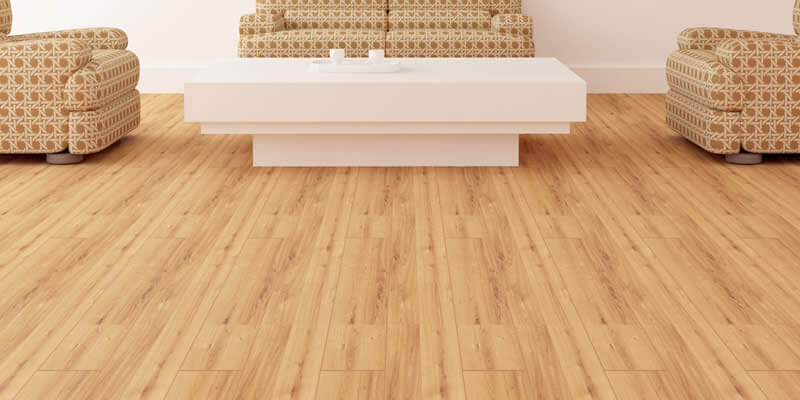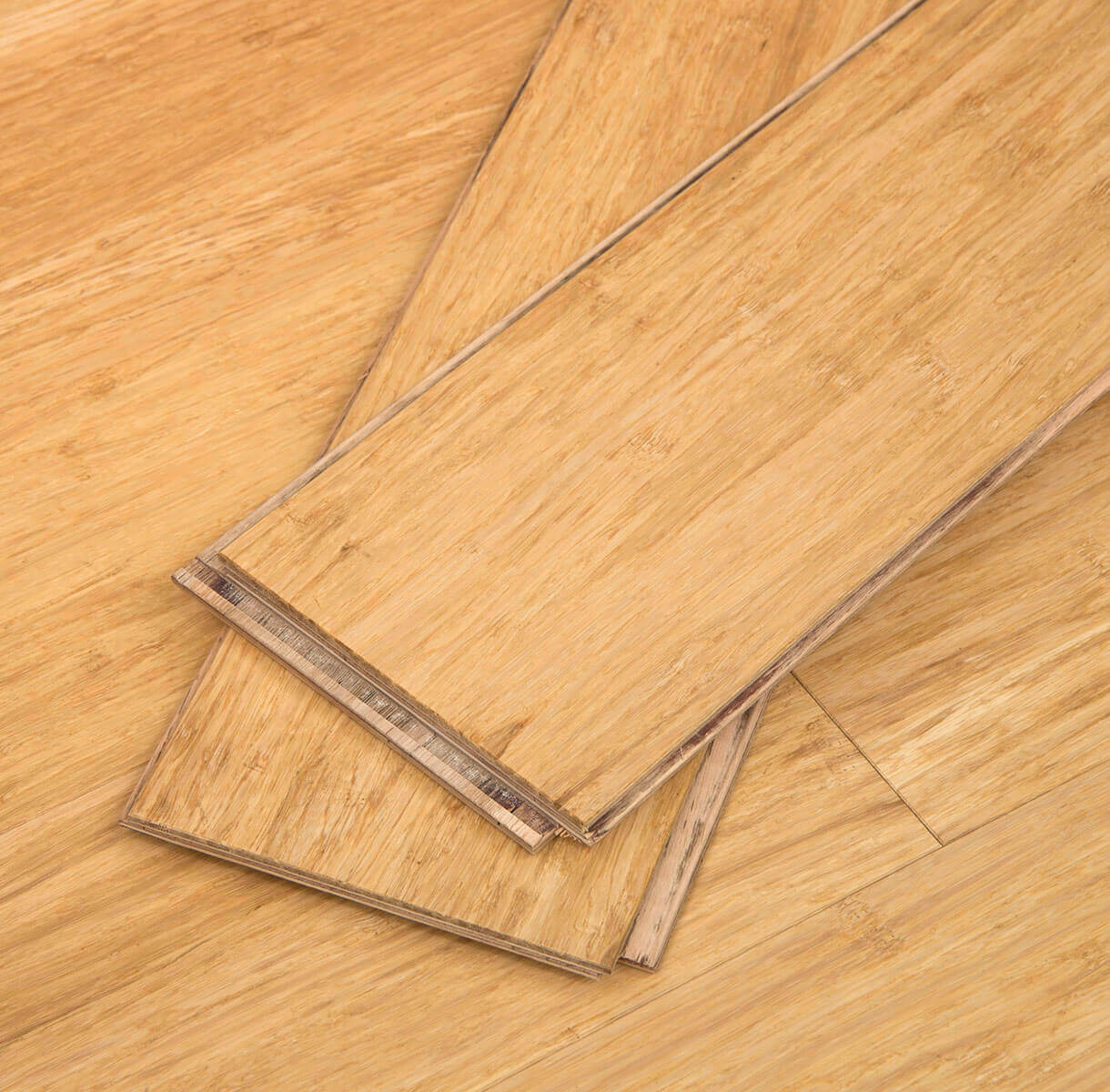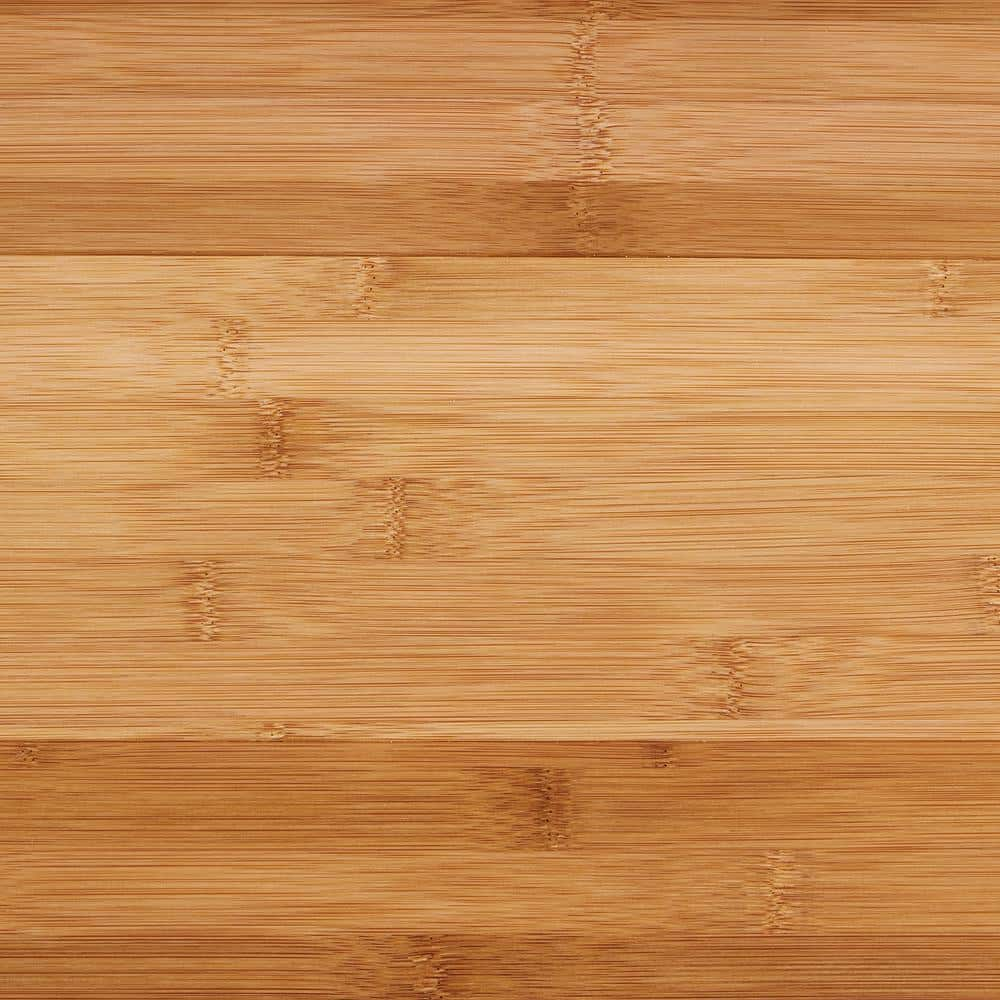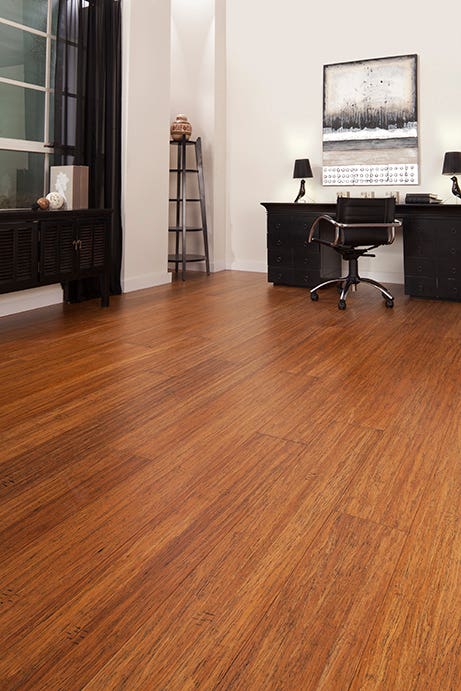What is Engineered Bamboo Flooring?
Engineered bamboo flooring is a modern, versatile alternative to traditional hardwood and solid bamboo flooring. It combines the natural beauty of bamboo with advanced engineering to create a durable and attractive flooring solution. If you’re considering an upgrade to your home’s flooring, this option might just strike the perfect balance between style, affordability, and sustainability.
- Definition and Composition
Engineered bamboo flooring is constructed from multiple layers. The top layer, or veneer, is made from natural bamboo, which gives it the authentic look of bamboo flooring. Beneath this veneer are layers of high-density fiberboard (HDF) or plywood, which provide added stability and strength. This layered structure ensures the flooring remains durable and resistant to environmental changes. - How It’s Made
The manufacturing process for engineered bamboo involves slicing bamboo stalks into thin strips, treating them to remove starch and pests, and then compressing the strips under heat and pressure. These treated bamboo layers are then adhered to a core material like HDF, creating a durable and stable product. - Key Features
What sets engineered bamboo apart is its combination of natural beauty and enhanced functionality. Unlike solid bamboo flooring, which can be more prone to expansion and contraction, engineered bamboo is designed to withstand fluctuating temperatures and humidity levels, making it suitable for a wider range of environments. - Ideal Applications
Engineered bamboo flooring works well in various settings, from living rooms and bedrooms to kitchens and even basements. Its versatility and moisture resistance make it a great choice for spaces where traditional wood flooring might not be suitable. - Why It’s Gaining Popularity
As homeowners look for sustainable and stylish flooring options, engineered bamboo has become a top contender. Its ability to mimic the elegance of hardwood while offering added durability and easier maintenance has made it a popular choice for modern homes. - A Sustainable and Stylish Choice
Overall, engineered bamboo flooring is a practical and eco-friendly option for anyone seeking a beautiful, long-lasting floor that aligns with contemporary design trends.

How Engineered Bamboo Differs from Solid Bamboo Flooring
When shopping for bamboo flooring, you’ll come across two primary options: engineered bamboo and solid bamboo. While both are derived from the same plant, their construction, performance, and applications differ significantly. Understanding these distinctions will help you make an informed decision.
Construction Differences
Solid bamboo flooring is made entirely from bamboo strips that are glued together to form planks. In contrast, engineered bamboo flooring consists of a thin bamboo veneer adhered to a core of HDF or plywood. This engineered structure provides enhanced stability, especially in environments with fluctuating humidity and temperature.
Performance and Stability
One major difference lies in how each type of flooring reacts to environmental changes. Solid bamboo expands and contracts more noticeably with changes in moisture and temperature, which can lead to warping or gaps over time. Engineered bamboo, thanks to its layered construction, is much more stable and less prone to these issues.
Durability and Wear
While both types of flooring are durable, engineered bamboo often has a tougher surface due to the finishing process. The wear layer on engineered bamboo can be highly scratch-resistant, making it a better choice for high-traffic areas or homes with pets and children.
Ease of Installation
Engineered bamboo is typically easier to install than solid bamboo. It often comes with click-lock systems for floating installations, whereas solid bamboo may require nails or glue. This makes engineered bamboo a more DIY-friendly option.
Aesthetic Choices
Solid bamboo offers a more uniform and natural look, as it’s crafted entirely from bamboo. Engineered bamboo, however, can be manufactured in a wider range of styles, finishes, and plank sizes, offering greater design versatility.
Cost Considerations
Engineered bamboo is usually more affordable than solid bamboo, both in terms of material cost and installation expenses. However, solid bamboo may have a longer lifespan if properly maintained, as it can be sanded and refinished multiple times.
The Benefits of Choosing Engineered Bamboo Flooring
If you’re weighing your options for new flooring, engineered bamboo has plenty to offer. From its durability to its eco-friendliness, this material delivers a range of advantages that make it a standout choice for modern homes.
Superior Stability
Engineered bamboo’s layered construction makes it incredibly stable, even in challenging conditions. Unlike hardwood or solid bamboo, it resists warping, shrinking, or swelling, making it suitable for spaces with varying humidity levels.
Durable for Everyday Use
Whether you have a bustling household with kids and pets or simply want a low-maintenance flooring option, engineered bamboo is up to the task. Its tough wear layer resists scratches, dents, and everyday wear, ensuring your floors stay beautiful over time.
Eco-Friendly Appeal
Bamboo is one of the most sustainable materials on the planet. Its rapid growth rate and ability to regenerate after harvesting make it an environmentally friendly choice. Engineered bamboo flooring retains these benefits while incorporating additional features for practicality.
Versatile Design Options
From natural tones to darker finishes, engineered bamboo offers a wide range of styles to complement any interior design. Whether your home leans toward modern minimalism or rustic charm, there’s an option to suit your taste.
Ease of Installation
With click-lock systems and floating installation options, engineered bamboo is simpler and quicker to install compared to traditional wood flooring. This can save you time and labor costs, especially for DIY projects.
Cost-Effective Investment
Engineered bamboo provides the look and feel of premium hardwood at a fraction of the cost. Its durability and low maintenance requirements make it a smart, long-term investment for homeowners.
Eco-Friendliness: Is Engineered Bamboo a Sustainable Option?
Bamboo is often hailed as a sustainable resource, but how does engineered bamboo flooring measure up? If eco-friendliness is a priority for your home renovation, this flooring option deserves a closer look.
Rapid Growth and Regeneration
Bamboo grows much faster than traditional hardwood trees, with some species reaching maturity in just 3-5 years. This rapid growth cycle makes it a renewable resource that can be harvested without depleting forests.
Low Environmental Impact
Harvesting bamboo doesn’t require the same level of deforestation as hardwood trees. Additionally, bamboo regenerates from its root system, eliminating the need for replanting. This makes it a more environmentally friendly choice compared to many other flooring materials.
Reduced Carbon Footprint
Engineered bamboo flooring often incorporates adhesives and finishes that may impact its eco-credentials. However, many manufacturers now use non-toxic, low-VOC (volatile organic compound) adhesives to minimize environmental harm and improve indoor air quality.
Recycled and Sustainable Core Materials
The HDF or plywood core in engineered bamboo flooring is often made from recycled wood products or sustainably sourced materials, further enhancing its eco-friendly profile.
Energy-Efficient Manufacturing
Some engineered bamboo flooring brands prioritize energy-efficient manufacturing processes, reducing the overall carbon footprint of their products. Look for certifications like FSC (Forest Stewardship Council) to ensure sustainable practices.
Longevity Reduces Waste
Because engineered bamboo flooring is highly durable and long-lasting, it doesn’t need to be replaced as frequently as other options. This contributes to less material waste over time, adding to its sustainability appeal.
Durability and Longevity: How Engineered Bamboo Stands Up to Wear
Durability is a top consideration when choosing flooring, especially in areas of your home that experience heavy foot traffic. Engineered bamboo flooring offers an impressive combination of strength and resilience, making it an ideal choice for those who want their floors to look stunning while standing up to the challenges of daily life.
Engineered Bamboo’s Strength
Thanks to its layered construction, engineered bamboo is designed to withstand wear and tear. The core layers, typically made of high-density fiberboard (HDF) or plywood, provide a sturdy foundation, while the bamboo veneer is treated to resist scratches and dents. This makes engineered bamboo suitable for homes with pets, children, or frequent visitors.
Scratch and Dent Resistance
Modern engineered bamboo flooring often features a tough wear layer that protects against everyday scratches and impacts. This is particularly important in kitchens, entryways, and living rooms, where furniture movement and foot traffic can take a toll on less durable flooring materials.
Moisture Resistance Enhances Longevity
Unlike solid bamboo, engineered bamboo is better equipped to handle moisture. Its cross-layered construction minimizes the risk of warping or swelling caused by spills, humidity, or temperature changes, which can extend the lifespan of your flooring.
UV Resistance for Fade Prevention
Many engineered bamboo floors are treated with UV-resistant finishes that help protect against discoloration from sunlight exposure. This ensures your floors retain their original color and vibrancy even in brightly lit rooms.
High-Quality Finishes for Extra Protection
The durability of engineered bamboo is further enhanced by its finish. Options like aluminum oxide or polyurethane coatings provide additional protection against stains, scratches, and general wear, ensuring your flooring stays beautiful for years.
Longevity with Proper Maintenance
With proper care and maintenance, engineered bamboo flooring can last 20 years or more. Regular cleaning, using furniture pads, and avoiding excessive moisture can help prolong its lifespan, making it a wise long-term investment.
Moisture Resistance: Why Engineered Bamboo Works in Kitchens and Bathrooms
One of the standout features of engineered bamboo flooring is its ability to resist moisture, a quality that makes it suitable for kitchens, bathrooms, and other areas prone to spills and humidity. Let’s explore why this is a game-changer for flooring options.
Layered Construction Reduces Warping
Engineered bamboo flooring’s multi-layered structure is designed to handle moisture better than solid bamboo or traditional hardwood. The HDF or plywood core stabilizes the planks, preventing them from expanding, contracting, or warping when exposed to humidity.
Protective Finishes Add a Barrier
Most engineered bamboo flooring is coated with water-resistant finishes, such as polyurethane or aluminum oxide. These finishes act as a barrier against spills and moisture, keeping the bamboo veneer intact and preventing water from seeping into the core.
Kitchens and Bathrooms: High-Moisture Areas
Engineered bamboo is particularly suitable for kitchens, where spills and splashes are common. In bathrooms, where humidity levels can fluctuate, its moisture resistance makes it a practical and stylish choice. However, it’s still important to clean up spills promptly to ensure longevity.
Comparing to Other Flooring Options
While it doesn’t match the water resistance of vinyl or ceramic tiles, engineered bamboo performs significantly better than solid bamboo or hardwood. Its balance of moisture resistance and aesthetic appeal makes it a versatile choice for various settings.
Seamless Installation Enhances Resistance
Proper installation is key to maximizing engineered bamboo’s moisture resistance. Floating floors with click-lock systems often leave gaps where water can seep in, so opting for glued-down installations in moisture-prone areas can offer extra protection.
Maintenance Tips for Moisture Control
To keep your engineered bamboo floors in top condition, use mats or rugs near sinks and appliances to catch spills. Additionally, ensure your kitchen or bathroom is well-ventilated to minimize excess humidity, further protecting your flooring from damage.
Design and Aesthetic Versatility of Engineered Bamboo
One of the most appealing aspects of engineered bamboo flooring is its design versatility. Whether your home leans toward modern minimalism, rustic charm, or eclectic style, there’s an engineered bamboo option to complement your vision.
A Wide Range of Colors
Engineered bamboo comes in an array of colors, from light natural tones to rich dark stains. You can choose traditional honey-colored bamboo for a classic look or opt for darker, espresso shades for a contemporary vibe. Whitewashed and gray finishes are also available for those who prefer a more modern, neutral aesthetic.
Various Textures and Finishes
The surface of engineered bamboo flooring can be smooth, distressed, or hand-scraped, allowing you to select a texture that aligns with your home’s style. Glossy finishes provide a sleek, polished appearance, while matte finishes offer a more understated, natural look.
Plank Sizes and Styles
From wide planks that create a spacious, open feel to narrow planks that add intricate detail, engineered bamboo offers flexibility in plank sizes. Some designs even mimic the appearance of traditional hardwood flooring, including patterns like herringbone or chevron.
Seamless Blending with Other Materials
Engineered bamboo flooring pairs beautifully with other materials in your home. Its neutral tones and natural grain make it an excellent match for stone countertops, wooden cabinetry, or stainless steel appliances.
Customizing with Stains and Finishes
Many manufacturers offer customizable options, allowing you to choose specific stains or finishes that align with your style. This level of customization ensures your flooring is uniquely tailored to your space.
A Timeless Appeal
While trends in flooring materials come and go, engineered bamboo offers a timeless look that can adapt to changing design preferences. Its ability to mimic the elegance of hardwood while maintaining its unique character ensures it remains a popular choice for years to come.
Installation Made Easy: Floating vs. Glued-Down Options
One of the many advantages of engineered bamboo flooring is the variety of installation methods it offers. Whether you’re a DIY enthusiast or hiring a professional, you’ll appreciate the flexibility and convenience of these two primary methods: floating and glued-down installations. Each option has its strengths, and understanding the differences can help you decide which is best for your home.
What is a Floating Installation?
A floating installation involves connecting engineered bamboo planks using a click-lock system or tongue-and-groove mechanism without adhering them to the subfloor. The floor “floats” above the surface, making it an easier and faster method. This option is particularly popular among DIYers due to its straightforward process and minimal equipment requirements.
Advantages of Floating Floors
Floating floors are cost-effective and versatile. They can be installed over various subfloors, including concrete, plywood, and even existing flooring. This method also allows for natural expansion and contraction, which can prevent buckling or gaps in areas with fluctuating humidity.
What is a Glued-Down Installation?
In a glued-down installation, each plank is adhered directly to the subfloor using a strong adhesive. This method creates a more permanent and stable flooring solution. It’s often used in areas where sound insulation is crucial or where a more solid feel underfoot is desired.
Advantages of Glued-Down Floors
Glued-down installations offer excellent stability, reducing the risk of creaking or shifting. This method is ideal for high-traffic areas or moisture-prone rooms, as the adhesive helps seal gaps and prevent water from seeping beneath the planks.
Choosing the Right Installation Method
The best installation method depends on your needs and circumstances. If you’re looking for a quick, DIY-friendly option, floating floors are a great choice. However, for a more professional and long-lasting solution, glued-down floors might be worth the investment.
Tips for a Successful Installation
Regardless of the method, proper preparation is essential. Ensure your subfloor is clean, level, and dry before beginning. If you’re tackling a DIY floating installation, follow the manufacturer’s guidelines carefully to avoid mistakes. For glued-down floors, consider hiring a professional to ensure precise application of adhesive and alignment.
Maintenance Tips for Keeping Your Engineered Bamboo Floors Beautiful
Engineered bamboo flooring is prized for its durability and low maintenance requirements. However, like any flooring material, it needs proper care to stay in top condition. By following these maintenance tips, you can keep your floors looking beautiful for years to come.
Daily Cleaning Habits
Regular sweeping or vacuuming is essential to prevent dirt and debris from scratching the surface of your flooring. Use a soft-bristle broom or a vacuum with a hardwood floor attachment to avoid damaging the finish.
Mopping the Right Way
When mopping, it’s important to use a damp—not wet—mop. Excess water can seep into the seams and cause damage over time. Opt for a microfiber mop and a cleaning solution designed specifically for bamboo or hardwood floors.
Protecting Against Scratches
Placing felt pads under furniture legs can prevent scratches when moving pieces around. Use rugs or mats in high-traffic areas, such as entryways and kitchens, to provide an extra layer of protection against wear.
Avoiding Harsh Chemicals
Harsh cleaning products can strip the protective finish on engineered bamboo flooring, leaving it vulnerable to damage. Stick to pH-neutral cleaners and avoid using ammonia, bleach, or abrasive tools like steel wool.
Dealing with Spills and Stains
Promptly clean up spills to prevent stains or moisture damage. For stubborn spots, use a soft cloth and a gentle cleaner. Avoid scrubbing too hard, as this can dull the finish.
Periodic Maintenance
Over time, the finish on your engineered bamboo flooring may wear down. Recoating or refinishing with a compatible product can restore its luster. If your floors have a thick veneer, light sanding and refinishing may be possible to address deeper scratches or wear.
Cost Comparison: Is Engineered Bamboo Worth the Investment?
When renovating your home, the cost of materials and installation is often a deciding factor. Engineered bamboo flooring is known for its affordability, but is it worth the investment compared to other options? Let’s break down the costs and benefits.
Material Costs
Engineered bamboo flooring is typically more affordable than solid hardwood but slightly more expensive than laminate. Prices range from $3 to $10 per square foot, depending on the brand, quality, and finish. While it’s not the cheapest option, it offers excellent value for its durability and aesthetic appeal.
Installation Costs
Installation costs vary depending on the method. Floating floors are usually less expensive to install, especially for DIYers. Glued-down installations may incur higher labor costs but offer a more stable and professional result. Overall, engineered bamboo flooring is a cost-effective choice for both DIY and professional installations.
Long-Term Savings
The durability of engineered bamboo flooring translates to long-term savings. Its resistance to scratches, dents, and moisture means you’re less likely to need costly repairs or replacements. Additionally, its low maintenance requirements can save you money on cleaning products and professional services.
Comparing to Other Flooring Options
Compared to traditional hardwood, engineered bamboo is a more budget-friendly option with similar aesthetic qualities. It’s also more affordable than natural stone or ceramic tiles, making it a versatile choice for a wide range of budgets.
Resale Value and Market Appeal
High-quality flooring can increase the resale value of your home. Engineered bamboo’s eco-friendly appeal and modern design options make it a desirable feature for prospective buyers, potentially boosting your property’s marketability.
Weighing Costs Against Benefits
While engineered bamboo flooring may not be the cheapest upfront option, its durability, sustainability, and aesthetic appeal make it a smart long-term investment. By balancing cost and quality, it provides excellent value for homeowners looking to upgrade their flooring.
Related Posts:

